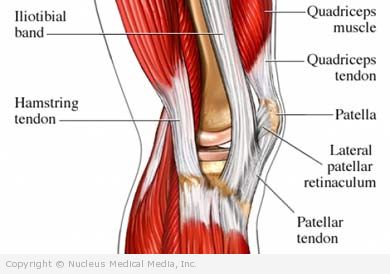Iliotibial band friction syndrome
(IT Band Syndrome; ITBFS)
Iliotibial band friction syndrome – Definition
Iliotibial band friction syndrome (ITBFS) is an overuse injury. It happens in the soft tissues in the lower thigh near the outside of the knee. The iliotibial band (ITB) is a thick band of fibrous tissue. It runs from the hip down the outside of the thigh and attaches to the tibia. The tibia is the large bone of the lower leg.
Iliotibial band friction syndrome – Causes
ITBFS is caused by repetitive friction or rubbing of the iliotibial band against the bone on the outer side of the knee. This excessive rubbing can irritate the ITB itself and/or the underlying tissue.
Causes of the excessive friction include:
- Structural abnormalities
- Incorrect training technique
- Increasing distance run or cycling too quickly
- Overtraining
- Equipment (eg, bicycle) that is not properly fit to the user
- Wearing improper shoes for a sport or athletic activity
- Using damaged or worn out equipment or footwear
- Failing to stretch properly
- Muscle imbalances due to not strengthening opposing muscles (such as the quadriceps and hamstrings)
Iliotibial band friction syndrome – Risk Factors
Risk factors for developing ITBFS include:
- A short, tight IT band
- A very prominent lateral femoral epicondyle (bony structure on the outer side of the knee)
- Problems related to the foot or hip
- Bowlegs
- Inward rotation of the leg
- Legs of different lengths
- Certain sports with repetitive motions, such as running and cycling
- Running up and down hills
Iliotibial band friction syndrome – Symptoms
Symptoms of ITBFS include:
- Dull aching or burning sensation on the outside of the knee during activity
- Sharp stabbing pain on the outside of the knee during activity
The pain may be localized. It generally radiates around the outside of the knee and/or up the outside of the thigh. Pain typically starts as minor discomfort. It can then worsen progressively. Snapping, creaking, or popping may be present when the knee is bent and then straightened. There is usually no swelling.
Iliotibial band friction syndrome – Diagnosis
The doctor will ask about your symptoms and medical history. A physical exam will be done. Diagnosis is based on these factors:
- Pain around the lateral femoral epicondyle
- Tenderness when pressure is applied to this area
- Pain that occurs when going from a straight leg to a bent knee
Tests may include:
- Ober’s test — determines the tightness of the ITB
- Renne’s test — specifies the area of pain while full weight is placed on the leg
- Noble’s test — determines the area of pain while the leg is flexed at a certain angle
Iliotibial band friction syndrome – Treatment
Treatment depends on the cause.
Treatment may include:
- Rest — restriction from activities that cause pain.
- Heat or ice — application of heat, ice (generally ice is applied after activity; heat may be used before exercise to loosen muscles and soft tissues)
- Exercise — may include stretching to lengthen the ITB and strengthening of the quadriceps and hamstrings to correct muscle imbalances
- Correct technique — evaluating and correcting running, cycling, and weight-training techniques
- Orthotics — custom orthotic supports to correct foot problems
- Medications — anti-inflammatory medications and/or local cortisone injections
- Surgery — only for extreme cases where other treatment options have failed
Iliotibial band friction syndrome – Prevention
Avoiding the causes of ITBFS is the best way to prevent it. This can include:
- Learning proper training techniques
- Wearing appropriate shoes for each sport
- Replacing athletic shoes as they show signs of wear
- Being aware of running surfaces
- Using properly-fitted equipment
- Increasing mileage run and weight lifted gradually. When lifting weights, do small increments each day
- Strengthening quadriceps, hamstrings, and gluteal muscles (muscles that make up the buttocks)
- Stretching the ITB
- Seeing a foot specialist for evaluation and orthotics, if necessary

